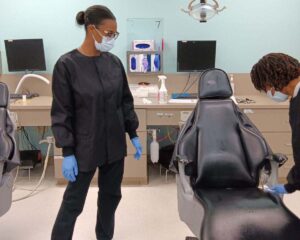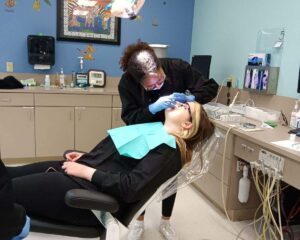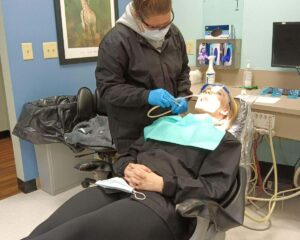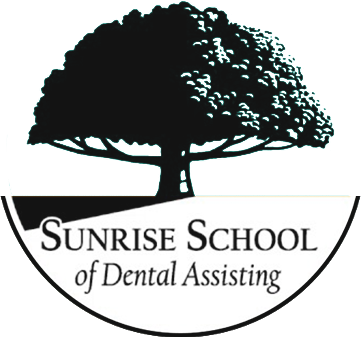Why Choose SSDA for your career in Dental Assisting?
Archives: Programs
Dental Assisting
The backbone of our school, the dental assisting course is 13 weeks of training from instructors with decades of experience in the dental industry. Our class sizes are intentionally kept small in order to give students the most individualized and one-on-one training possible. We take a hands-on approach in our training, giving students ample preparation for the professional world of dental assisting. Students receive focused education in chair side techniques, instrument setup and sterilization, laboratory terminology and procedures, and an overview of dental health, oral anatomy, and preventive dentistry.
All graduates of our dental assisting program receive the following:
- A certificate in Dental Assisting I
- North Carolina Radiology Certification
- CPR Certification
- A certificate for completion of OSHA and Office Emergency training
- A certificate in sterilization and infection control
These qualifications put our graduates on the fast track to Dental Assistant II status. To learn more about the different dental assistant levels and certifications, please visit our Dental Assistant Certification page.
The backbone of our school, the dental assisting course is 13 weeks of training from instructors with decades of experience in the dental industry. Our class sizes are intentionally kept small in order to give students the most individualized and one-on-one training possible. We take a hands-on approach in our training, giving students ample preparation for the professional world of dental assisting. Students receive focused education in chair side techniques, instrument setup and sterilization, laboratory terminology and procedures, and an overview of dental health, oral anatomy, and preventive dentistry.
All graduates of our dental assisting program receive the following:
- A certificate in Dental Assisting I
- North Carolina Radiology Certification
- CPR Certification
- A certificate for completion of OSHA and Office Emergency training
- A certificate in sterilization and infection control
These qualifications put our graduates on the fast track to Dental Assistant II status. To learn more about the different dental assistant levels and certifications, please visit our Dental Assistant Certification page.
Front Office Administrator
The functions of a front office are vital to the everyday successes of a dental practice. Similar in concept to dental assistants, front office administrators are another type of auxiliary staff who serve an important role on the dental team. This course is for students wishing to obtain a career in the administration side of dentistry.
During this 9-week course, students will learn:
- How to dress, communicate, and present oneself as a professional
- Dental anatomy and terminology
- How to proficiently and accurately verify and process insurance claims
- Coordinate schedules and keep the operations of the office running smoothly
- A thorough understanding of the rules, laws, and guidelines of HIPAA Privacy Act.
Nine-Week Course Outline
Week 1: Orientation to the Dental Administration Profession
3 Hour Lecture / 3 Hour Lab
- Roles of the Administrative Assistant,
- Dental Terminology,
- Ethics & Law / HIPAA,
Week 2: Medical Office Emergencies / CPR
1 Hour Lecture / 2 Hour Lab
- CPR instruction
Week 3: Customer Service
3 Hour Lecture / 3 Hour Lab
- Communication Skills
- Telephone Techniques & Etiquette
- Receiving the Patient
Week 4: Scheduling/ Clinical Records
3 Hour Lecture / 3 Hour Lab
- Introduction to Eaglesoft
- Scheduling New/Existing Patients; Forms
- Clinical Records/ Records Management; Patient Documentation
Week 5: Daily Schedule
3 Hour Lecture / 3 Hour Lab
- Scheduling to Goals
- Recall System; Appointment Confirmations
- Chart Reactivation
Week 6: Dental Insurance
3 Hour Lecture / 3 Hour Lab
- Insurance Verification
- Fee Schedules
- Electronic Claims Filing
Week 7: Office Accounting
3 Hour Lecture / 3 Hour Lab
- Accounts Payable/ Receivable
- Financial Arrangements
- Collection Procedures
Week 8: Other Administrative Duties
3 Hour Lecture / 3 Hour Lab
- Computer Software
- Marketing
Week 9: Program Conclusion
1 Hour Lecture / 2 Hour Lab / 1 Hour Written Exam / 1 Hour Lab Final
- Resume & Interview Techniques
- Course Review
- Final Exam
The functions of a front office are vital to the everyday successes of a dental practice. Similar in concept to dental assistants, front office administrators are another type of auxiliary staff who serve an important role on the dental team. This course is for students wishing to obtain a career in the administration side of dentistry.
During this 9-week course, students will learn:
- How to dress, communicate, and present oneself as a professional
- Dental anatomy and terminology
- How to proficiently and accurately verify and process insurance claims
- Coordinate schedules and keep the operations of the office running smoothly
- A thorough understanding of the rules, laws, and guidelines of HIPAA Privacy Act.
Nine-Week Course Outline
Week 1: Orientation to the Dental Administration Profession
3 Hour Lecture / 3 Hour Lab
- Roles of the Administrative Assistant,
- Dental Terminology,
- Ethics & Law / HIPAA,
Week 2: Medical Office Emergencies / CPR
1 Hour Lecture / 2 Hour Lab
- CPR instruction
Week 3: Customer Service
3 Hour Lecture / 3 Hour Lab
- Communication Skills
- Telephone Techniques & Etiquette
- Receiving the Patient
Week 4: Scheduling/ Clinical Records
3 Hour Lecture / 3 Hour Lab
- Introduction to Eaglesoft
- Scheduling New/Existing Patients; Forms
- Clinical Records/ Records Management; Patient Documentation
Week 5: Daily Schedule
3 Hour Lecture / 3 Hour Lab
- Scheduling to Goals
- Recall System; Appointment Confirmations
- Chart Reactivation
Week 6: Dental Insurance
3 Hour Lecture / 3 Hour Lab
- Insurance Verification
- Fee Schedules
- Electronic Claims Filing
Week 7: Office Accounting
3 Hour Lecture / 3 Hour Lab
- Accounts Payable/ Receivable
- Financial Arrangements
- Collection Procedures
Week 8: Other Administrative Duties
3 Hour Lecture / 3 Hour Lab
- Computer Software
- Marketing
Week 9: Program Conclusion
1 Hour Lecture / 2 Hour Lab / 1 Hour Written Exam / 1 Hour Lab Final
- Resume & Interview Techniques
- Course Review
- Final Exam
Nitrous Oxide Sedation Certification
According to North Carolina State law, a dental assistant cannot monitor patients while the patient is receiving nitrous oxide unless they have completed an approved 7-hour course on nitrous oxide training.
Our 7-hour nitrous oxide certification is designed specifically to endow graduates with the ability to aid and assist licensed dentists in the administration of nitrous oxide, as well as the credentials to monitor nitrous oxide patients. These qualifications are highly valued by dental practices.
Our course covers the following topics:
- State regulations
- The physiologic and pharmacologic effects of anesthesia
- Indications and contraindications for nitrous oxide administration
- Equipment used in administering nitrous oxide
- Analgesia vs. anesthesia
- Clinical manifestations of analgesia/anesthesia
- Side effects and adverse reactions
- Preparation and techniques for nitrous oxide administration
- Legal considerations and chart entries
- Occupational exposure
Certification is awarded to students who complete the course and score 75% or greater on the final exam.

According to North Carolina State law, a dental assistant cannot monitor patients while the patient is receiving nitrous oxide unless they have completed an approved 7-hour course on nitrous oxide training.
Our 7-hour nitrous oxide sedation certification is designed specifically to endow graduates with the ability to aid and assist licensed dentists in the administration of nitrous oxide, as well as the credentials to monitor nitrous oxide patients. These qualifications are highly valued by dental practices.
Our course covers the following topics:
- State regulations
- The physiologic and pharmacologic effects of anesthesia
- Indications and contraindications for nitrous oxide administration
- Equipment used in administering nitrous oxide
- Analgesia vs. anesthesia
- Clinical manifestations of analgesia/anesthesia
- Side effects and adverse reactions of nitrous oxide sedation
- Preparation and techniques for nitrous oxide administration
- Legal considerations and chart entries
- Occupational exposure
Certification is awarded to students who complete the course and score 75% or greater on the final exam. Contact us today to learn more about our nitrous oxide sedation certification program or sign up for our course by sending us this application.
Dental Radiology
Our 3-week dental radiology course expands on the basics learned in our dental assistant program, and gives graduates numerous additional skills that are in high demand at dental offices. During this course, students experience a mix of classroom and hands-on learning in a lab with live, mock patients. Students in this program learn:
- The history of radiology and associated risks
- The difference between x-ray units and x-ray films
- The different types of x-rays, including panoramic and cephalometric
- Proper processing and mounting of x-rays
- When and how to use different types of x-rays
- How to use digital imagery and equipment
- Correct sensor placement
- Common radiographic errors and how to avoid them
- State and OSHA safety laws
During the radiology training course, students also learn the basics of injection techniques as well as how to monitor patients on nitrous oxide.
Successful completion of the radiology program requires passing a written exam with a score of 70% or better, as well as demonstrating proficiency in obtaining a full mouth series with 85% proficiency or greater. The full mouth series is performed on a live patient.


Our 3-week dental radiology course expands on the basics learned in our dental assistant program, and gives graduates numerous additional skills that are in high demand at dental offices. During this course, students experience a mix of classroom and hands-on learning in a lab with live, mock patients. Students in this program learn:
- The history of radiology and associated risks
- The difference between x-ray units and x-ray films
- The different types of x-rays, including panoramic and cephalometric
- Proper processing and mounting of x-rays
- When and how to use different types of x-rays
- How to use digital imagery and equipment
- Correct sensor placement
- Common radiographic errors and how to avoid them
- State and OSHA safety laws
During the radiology training course, students also learn the basics of injection techniques as well as how to monitor patients on nitrous oxide.
Successful completion of the radiology program requires passing a written exam with a score of 70% or better, as well as demonstrating proficiency in obtaining a full mouth series with 85% proficiency or greater. The full mouth series is performed on a live patient.
